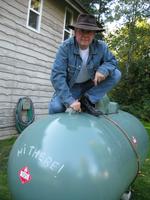Generator, Summer 2010
We moved to Vancouver Island in the spring/summer of 2006. Since that time, we have experienced two major power outages per year - one in November and one sometime in January to March. Sometimes the outage is brief - an hour or less, but frequently the outages are 6 hours or more. Last year we had a roughly 6 hour outage in November, and then a 9 hour outage in March this year.
The outages are mostly an inconvenience, but the house is on a well, with an electric pump. No power means no water. In addition, the house is heated entirely with baseboard heaters, so again no power means no heat. We are 6km from the nearest natural gas pipe, so propane would have to be the fuel of choice for a furnace. The house was not designed for forced-air heating however, so a retrofit would be very costly (as are those fuels on the Island).
The real problem with power outages, as we found this past March 2010, are that in colder weather everything cools down during a long outage. Once the power is restored, heaters all over the house kick in to warm the house and water, plus the various 'icebox' appliances also must restore their ideal temperature.
I have a TED (The Energy Detective) meter on the house main power panel with one display in the kitchen and one that is connected to the house server for data collection. Nominal "spot" power readings vary from 1.2KW to 5.5KW during normal household activity, with peaks of up to 11KW during heavy activity (i.e. washing plus cooking).
After the March 2010 outage, power use jumped to over 15KW as the house recovered - and this was in spite of using the new pellet stove on the main level which kept the main level baseboard heaters from adding to the load!
As a result, we decided that a backup generator would be a good thing to have - by keeping power to the house during an extended outage, it would allow the household to operate at the nominal levels (1.5KW - 5.5KW) and prevent the need for massive power use after the power outage was over. That is, with nominal power and a bit of conservation, the hot water would stay hot, the warm house would stay warm - all using normal amounts of power. With this in mind I sized the appropriate generator in the 12-20 KVA range. I also determined that propane power would be an overall better choice for my application than gasoline or diesel - the fuel was cleaner to store and burn, and the generator maintenance would also be reduced with propane.
With the basic specifications in hand, I then turned to the internet to search out affordable, obtainable generators. After much searching and researching, the Generac line of generators headed the list. They offered generators with excellent specifications of 8, 10, 12, 17 and 20 KVA. All were "dual fuel", meaning they would run on natural gas or propane. The 10, 12 and 17 KVA generators were particularly appealing - they had additional features designed to provide cleaner power for electronics, plus came with an appropriate automatic transfer panel. They were also priced quite reasonably. Although I liked the 20 and 25KVA generators, they were very expensive and the 200W transfer panel they required had to be purchased separately. After further specification refinement, I decided that the 17KVA Generac generator with 100W automatic transfer panel was the one to buy.
Of all places to purchase generators for the home, Home Depot had the best selection and prices, plus sold the entire Generac line. On June 1, I placed my order for a 17KVA Generac from Home Depot in Nanaimo.
I received a phone call on June 21 indicating the generator had arrived, and delivery would occur on June 23. At 550 lbs crated and on the pallet, I thought $60 for delivery was quite resonable. The generator would be unloaded and stored on the concrete pad at the front of the house, under the deck. It would be placed nearby as the main house power feed is at that corner.
Just before 10am, the generator arrived. The Home Depot truck came with a portable forklift, and so the generator was unloaded and set in place in short order. The truck left and I started to unpack the unit.
First oddity - opening the cardboard cover I found a grey panel sandwiched between the layers of cardboard. "Curious" I though. Once I had the cardboard removed from the crate, I removed the enormously heavy transfer panel and examined the generator. Immediately I could see a dent in the front cover, which lined up with damage in the box. Although not a massive dent, it was still disappointing when one has paid full price for something and expects "pristine".
Then the real crunch: on the side of the generator, the access panel door was missing. Actually, not missing as I had found it loose when opening the box. However, close inspection indicated it had been violently torn off and could not be easily repaired. Further, the access area is factor installed and cannot be easily replaced. Immediately I called Home Depot to report the damage. To their credit, I was called back by a manager within 5 minutes, who indicated the damaged unit would be picked up for return as soon as the driver could return (2 hours as it turned out). I was also told that a replacement had been ordered. It would (again) be a two-week delay, but better than damaged goods.
Below are photos I took of the unit - especially the damaged areas


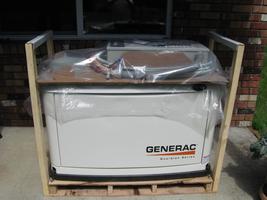
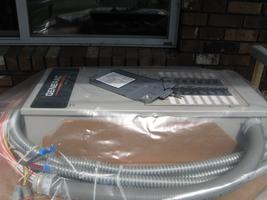

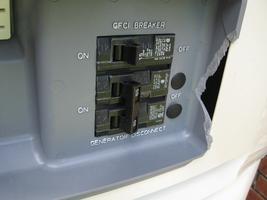


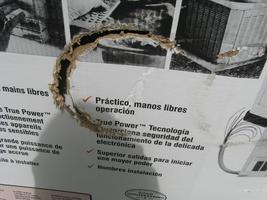
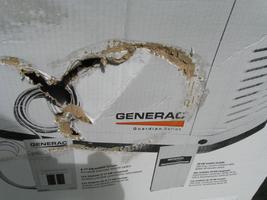
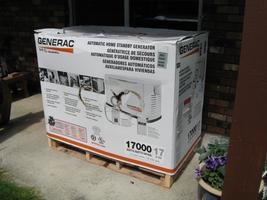
After the damaged generator was returned to Home Depot, I got a call informing me that they had inspected the damaged generator and wanted to "fix" it. I asked them to check again, as the broken access panel door was not field serviceable, and in conjunction with the dents, I wanted a new generator as that is what I had purchased.
After what seemed like a long wait, I got another phone call telling me the replacement generator had arrived and would be delivered that day. As promised, the truck arrived and the new generator was unloaded. This time, the driver and I unpacked the unit and did a complete inspection before I accepted delivery. The unit was perfect except for a small scratch in the top possibly caused by the transfer panel shifting in transit. I will paint that scratch.
After unpacking, I placed the cardboard box back on the generator and covered it with a tarp to protect it from both weather and prying eyes. There it sits as I now must prepare the ground for placement and obtain a propane tank and regulator.
Ground work is desribed on the yard 2010 page. Once the generator is placed on the pad, we'll return to this page for further generator updates.
The preparation work for the gravel bed is complete. I have to order 7 yds of pea gravel and then spread it into the prepared area.
The generator gravel frame is also complete. Once the main pea gravel area is complete, I will place the generator gravel base beside the house, then fill it with more pea gravel. After that I can move the generator into it's final position and start the connection / propane / wiring process.
For now, the completed frame sits in front of the generator, which is under the tarp in the photo.

On August 6, I finally Bedrock about obtaining some gravel for the entire front area. After consultation with Brian of Bedrock, Linda and Bill (my neighbor who is a concrete master), we elected to pour concrete for the front. The side area will be curbed off and filled with pea gravel to 6in as a pad for the generator. Given the drainage and grade, I will not be using the 4x6 frame to hold additional gravel.
On August 8, I bought another 8ft. length of 1x6 to crib the open end of the side area (for gravel) plus lag bolts. Once home I added the 2x6 to complete the gravel frame and also repositioned it to make a nice transition edge for the concrete.

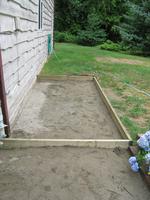
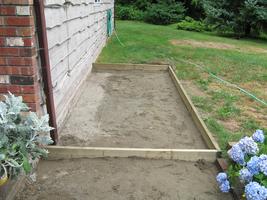
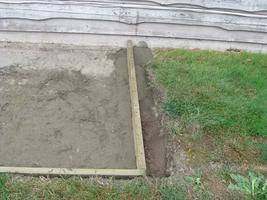



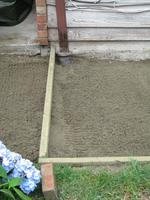
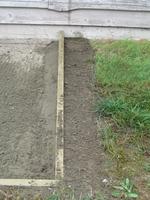
Today I drove the white pickup (Ford F350 4x4) to Bedrock, which is really close to our place, to pick up a couple of scoops of pea gravel. Unfortunately, the tailgate decided to fall off while loading, but I was still able to get more than enough pea gravel. I also managed to pick up the spillage with a shovel once the tailgate was reattached and secured.
Once home I proceeded to load wheelbarrows full of gravel and place them in my prepared frame. I lost count, but used about 1/2 of the gravel obtained. Each wheelbarrow load took 30 shovels of gravel, and I used somewhere between 8 and 10 wheelbarrows of gravel. After the first 4 loads I used a rake between loads to level the gravel and push it into all the corners. Now, I'll let the gravel settle overnight (or longer) and then top up the area and level it off again.
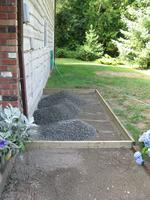
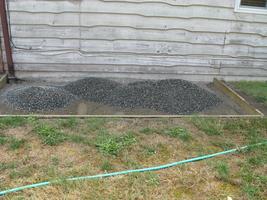
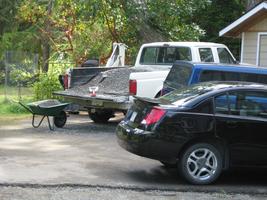
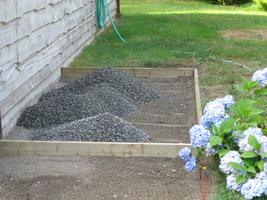
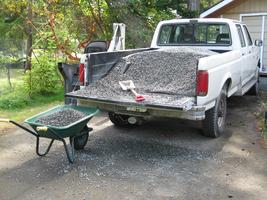
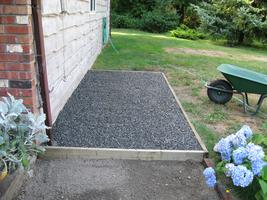
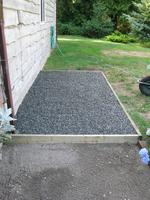


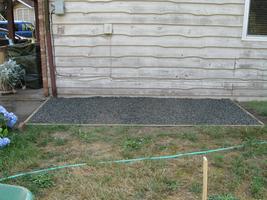
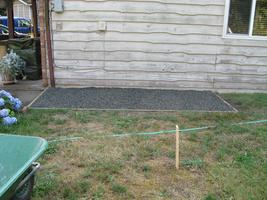
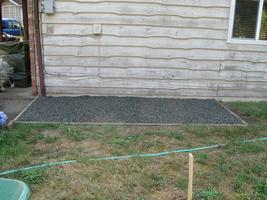
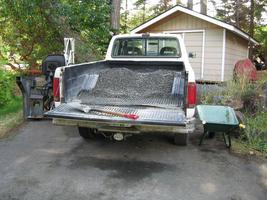
Main Electric Panel Rewiring (to remove panel #2) - Phase One: Expose panels and assess situation...
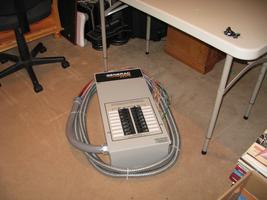
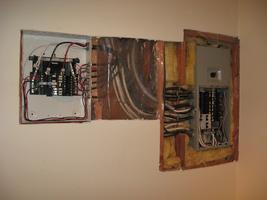
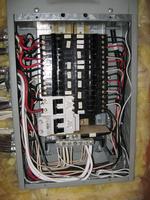
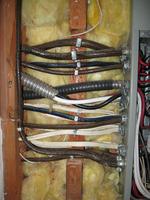

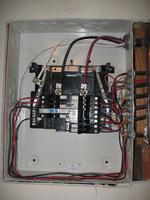
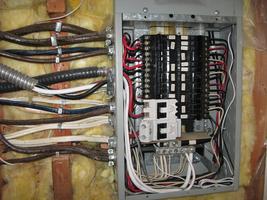
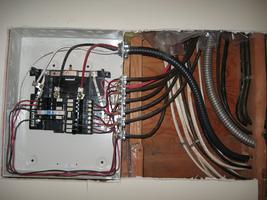
Main Electric Panel Rewiring (to remove panel #2) - Phase Two: Relocate circuits from panel #2 back to panel #1...


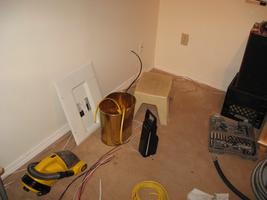


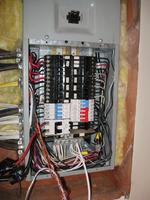



Main Electric Panel Rewiring (to remove panel #2) - Phase Two: Relocate circuits from panel #2 back to panel #1...
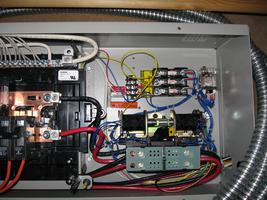
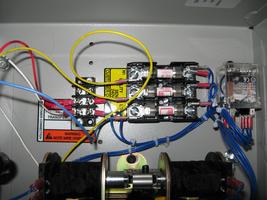
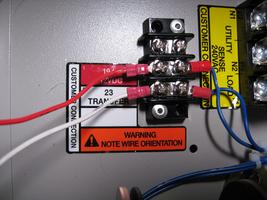
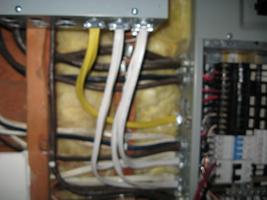
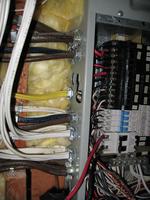
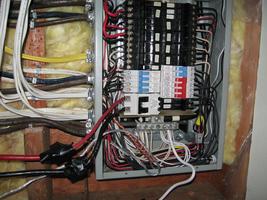
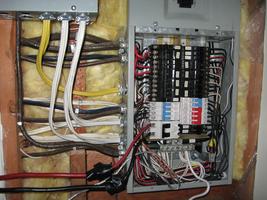
Fitting generac transfer panel support plywood, supporting replacement gyproc panel (to be installed later) and reinstalling insulation and vapor barrier.



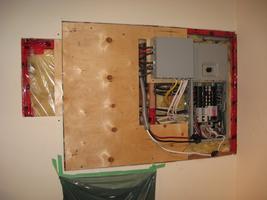
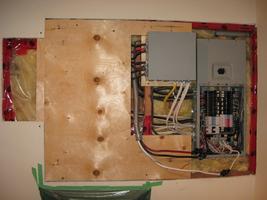
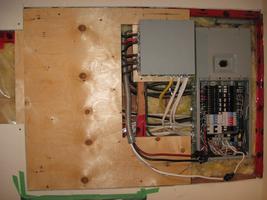
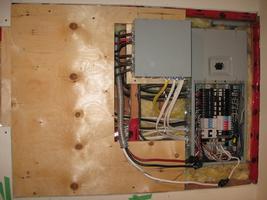
Finishing up with insulation and sealing vapor barrier and installing generac transfer panel support plywood.


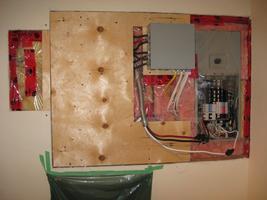

Wiring the garage junction box. The garage feed is 1Ga aluminum wire inside a 1in armour conduit. The conduit was too short to reach the generac panel, and the 1ga wire (100A) was more than necessary for the garage circuit (50A), so a junction box was added to properly terminate the conduit and allow a smaller pigtail for the wires. From 1Ga to 6Ga (50A) via copper split nugs, anti-oxide coating and then several wraps of electrical tape plus a rubber outer sheath. Proper ground bonding was maintained throughout.
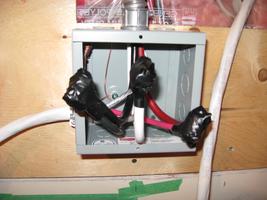
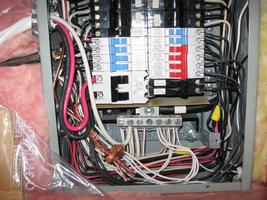


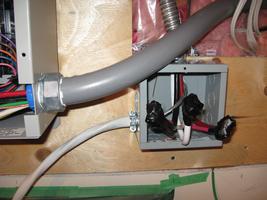
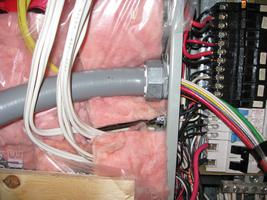
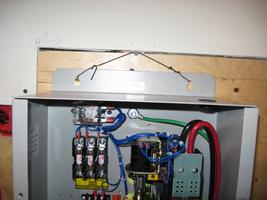
Today I moved circuits from the main panel to the generac transfer panel as per BC Wiring code and the Generac instructions. The garage was a direct connection from the garage junction box via a 90degree 3/4in fitting which I located in the blanking plate where the main generac conduit could exit from the left. All other circuits were located in the main panel; then the breaker was turned off, the wire(s) removed from the breaker and maretted to the appropriate conduit transfer wire which was connnected to the appropriate breaker in the generac panel (also off). Finally, once the connection was double-checked, the generac breaker was turned on and power confirmed to the now transferred load. In this way all generator-powered circuits were transferred and tested.
Once all the circuits to be moved were completed and tested, the wiring was neatly arranged nd both panels buttoned up.












During lunch hour, I fired up the Bobcat, arranged my lifting straps and moved the generator from it's location on the pallet under the tarp to the final location on the pea-gravel pad beside the house. After much concern about the move, it turned out to be almost anti-climatic in simplicity. As usual, the Bobcat performed flawlessly, moving the generator with ease and precision.
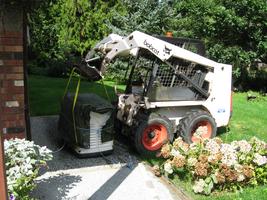
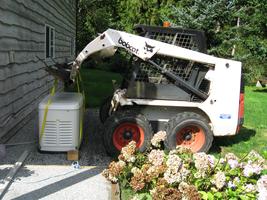
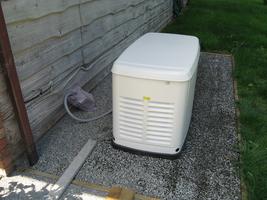
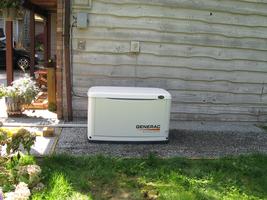
As the generator placement was considerably easier than anticipated, I went to work and installed the external connection box as well. This involved locating the box at an appropriate level (not too high, but not so low as to preclude easy access for connections). Inside the house I removed a section of drywall, locating a stud for reference. Using the stud, I drilled a pilot hole to the outside. From the outside, I used the pilot hole to locate the main 1 5/8in hole for the conduit and drilled the hole. I then passed the conduit through the hole and secured it to the transfer box as per the directions. Once secured, I mounted the transfer box using small lag bolts and RTV silicon to seal the hole, and the box to the wall. Once complete, the connections were made and the box buttoned up.
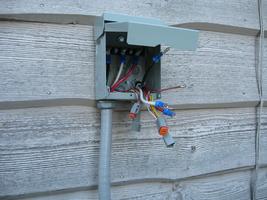
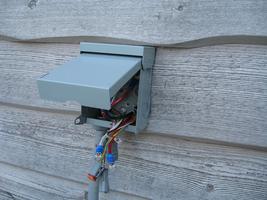
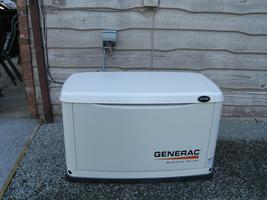
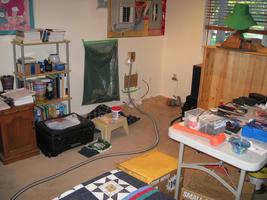
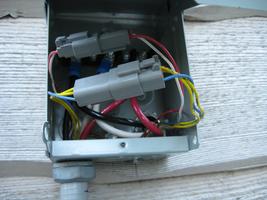
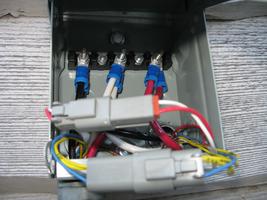
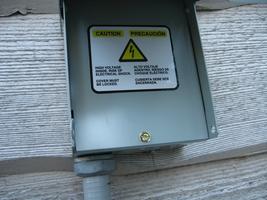

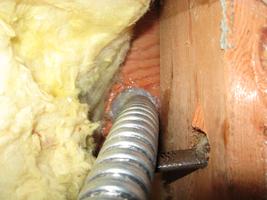
The generator is in place, and almost ready for propane.
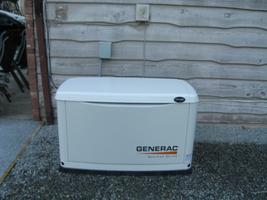

Later in the evening, I started patching the gyproc where cuts had been made and the second panel removed. As you can see, I had a helper.
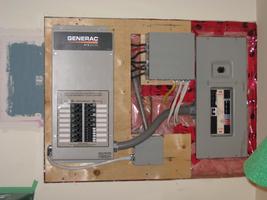
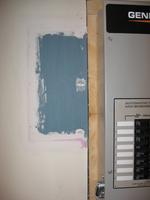
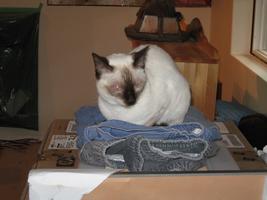

Inside, the conduit was run vertically inside the wall to the plywood, then up to the generac box. The conduit required significant shortening (from the supplied 30ft to about 6ft). New lugs were bonded to the control wires, then all control lines and main power lines were connected as per the wiring diagram. The final wiring of the generac panel was completed.
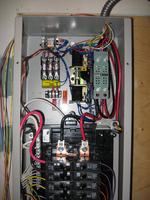
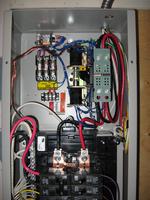

This picture shows the finished generac transfer panel fully wired and operational.

Today I installed the generator ground and the battery. The ground was a 4meter length of 6Ga ground wire, bonded to the generac frame and then rounted over to the house and up to the main house exterior ground location. The battery was a bit of a squeeze, but not having side posts really helped in this case. Bettery tests proved A-OK.

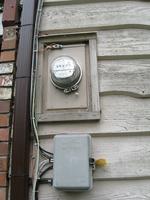
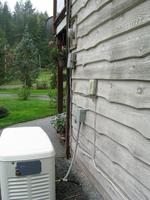
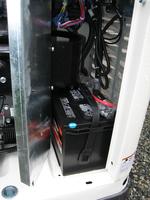

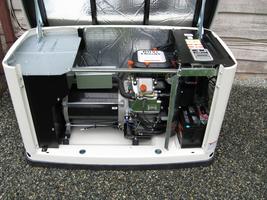
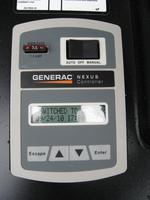
I checked all my propane/ng fittings, but do not have the correct adapter to allow me to test the generator using my 100lb propane tank today. I'll have to purchase an appropriate adapter next week. Meanwhile, I took some pictures of the generator information and a picture of the completed electrical panels with finished wallboard patches.
STATUS: Generator installation is complete with the exception of fuel for the generator. I need to obtain a fairly large propane tank, install the tank, plumb the gas fittings and fill the tank. Then the final generator checks can be completed and the generator set on automatic, ready to supply power during an outage.
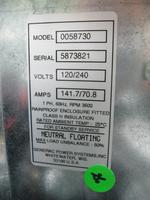

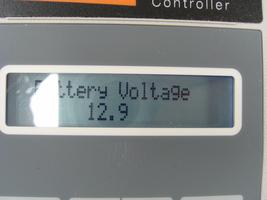
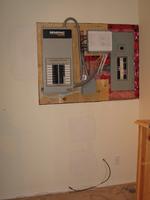
Today, while waiting for the propane supplier to call back, I decided to install my second TED (The Energy Detective) transducer into the Generac RTS panel. After recording the serial number for use in programming the display, I clamped the transducers to the power feed into the panel (red / black). I chose to monitor the power afeter the transfer relay, so can monitor power use under utility power and under generator power. After connecting the power leads to the transmitter, I turned on a TED meter, programmed the transducer number and watched as it displayed the power running through the Generac RTS. As expected, it's just over 1/2 the power used by the whole house, as read using my primary TED connected to the main panel.
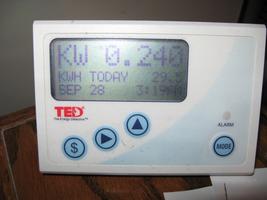
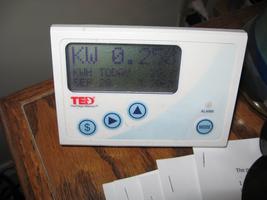
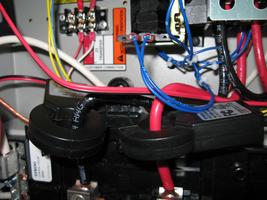
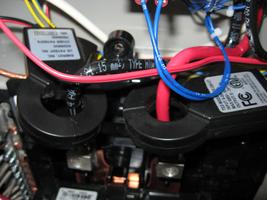
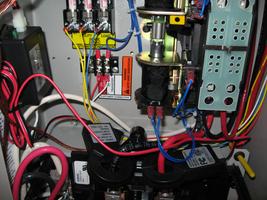
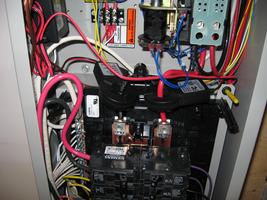
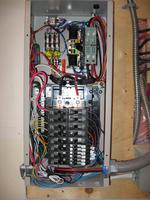
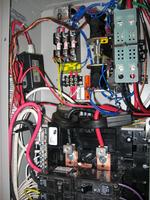
I've been monitoring the TED connected to the RTS, and it's not as expected. The whole-house TED (connected to the main house panel) was showing 1.5kW, but the highest the RTS TED would display was 0.7kW. I wasn't sure if this was correct until this morning, when the hot water heater kicked in. House power use went from 1.5kW to 4.5kW, but the RTS still showed 0.7kW. By shutting off the 20A two phase breakers (in both panels) in sequence, I was able to 'prove' the hot water heater was the item responsible for the increase in power use. However, the water heater breaker is on the RTS panel, so both TED displays should have shown the power use.
A quick read through the TED manual troubleshooting section directed me to check the polarity of the two QX200CT units (the CT's in TEd-speak). These are the clamp-on current transducers. Each has a red dot on one face showing polarity. Both must face the same direction when clamped on the power cables. Of course, mine were not facing the same way. A quick adjustment, and the RTS TED began displaying the correct power use. While in the RTS, I elected to use double-stick foam tape to mount the TED's MTU (measuring transmitting unit) on the side of the RTS before buttoning up the RTS.
Now both TED units are correctly displaying power used - one displaying power used for the whole house, and the other displaying power used by circuits connected to the RTS.
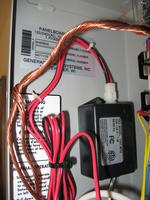
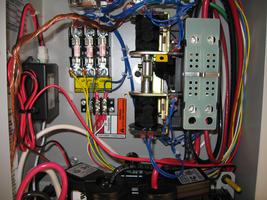
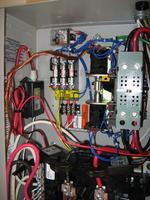

After some frustration with propane suppliers on the phone (many 800 numbers go to a central 'team' in Ontario, others just don't seem to comprehend generator installations), I emailed Superior asking for specifics on propane installation costs. I got a call back on September 30 from Nicole, located in Campbell River on the island. Not only did she answer all my questions, but set up a free site inspection with Ryan, the local Superior gas fitter.
Ryan came out about 1/2 hour later and together we went over the tank installation as well as some other details. Because it's a generator installation, they don't lease tanks as they just don't get filled enough to offset the tank cost. Instead they would sell me a reconditioned 500 gallon (1600 liters) tank for a very reasonable price. Installation was also reasonable and included everything from tank delivery until the generator was operational. After completing some paperwork, installation was set for October 12, 2010.
Due to a small delay, propane tank installation was postponed until today. Ryan and Rod came with the tank, which was a smaller 500lb tank (8 ft. long instead of 10-11 ft. long). It looked quite nice sitting on the truck. Rod unloaded the tank to the lawn, then I dragged the tank into place (dragging is actually easier on the grass and the tank) using my bobcat.
One the tank was in place, Ryan dug a trench for the line from tank to house, after which Rod started on the pipe from tank to house. Ryan then went to work making up various fittings and lengths of pipe that would properly connect the tank and regulators to the generator. It took from noon to about 4pm, but the work was exceptional. It was a very lovely thing to hear the generator fire up for the first time!
I am now waiting for the propane delivery truck to come and fill the tank, as it only had 50liters when delivered - both for weight, safety, and to provide enough to test the generator. Delivery is expected within a week.
Ryan and Rod were awesome fellows and did a terrific job!
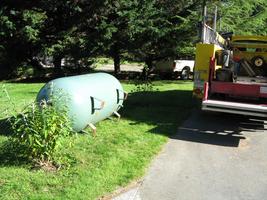
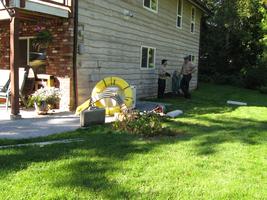
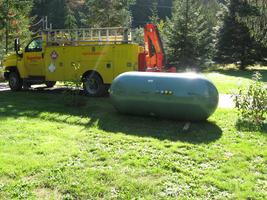

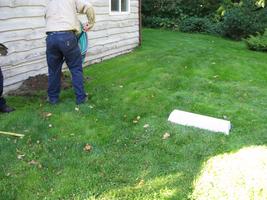
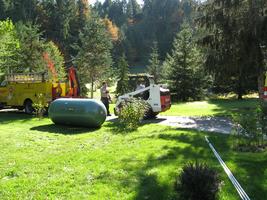
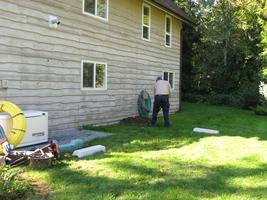
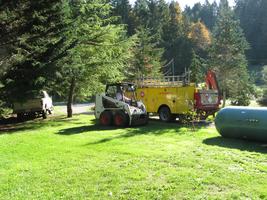
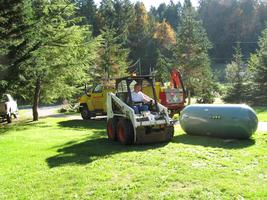
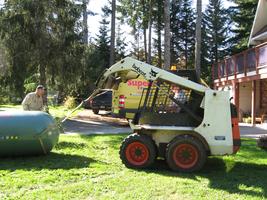
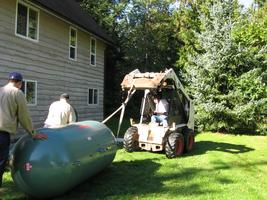
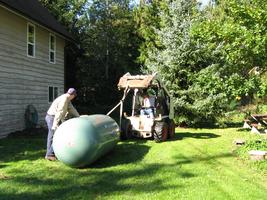
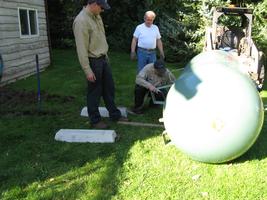
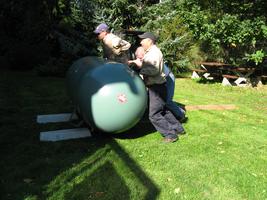
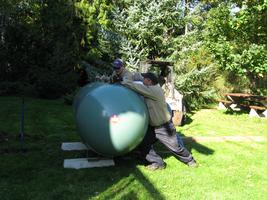
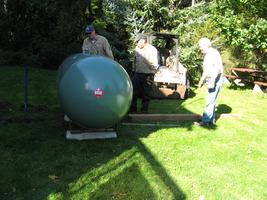
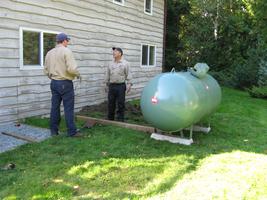

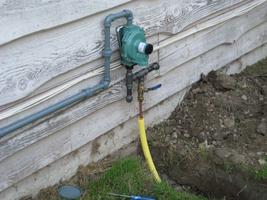
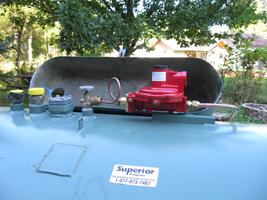
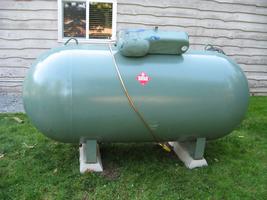

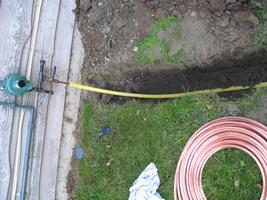

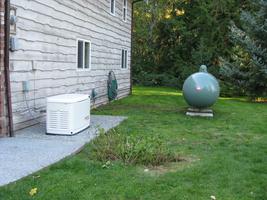
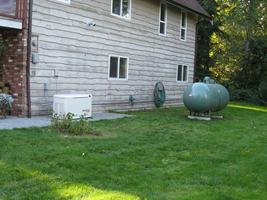
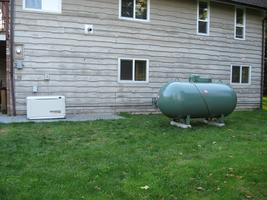
A little bit frustrating - I won't get propane delivery until October 19, almost a week from the tank installation. Meantime, I contacted the supplier to check on pricing, which seems OK. I explained that I wanted to do the final electrical tests and required a few hours run-time to do that, hence the desire for propane sooner rather than later. I was told I should have about 150 liters in the tank, "go ahead and do your testing".
With that news, I walked over to the electrical panels and turned off the breaker to the Generac RTS. Ten seconds later (as per spec) I heard the generator start, and five seconds after that the power was transferred to the generator with a mighty "CLACK". Power was stable and accurate to the stated power requirements of the manual (250V, 60hz). Everthing was working very well on the generator, although I did not fire up everything like hot water tank or baseboard heaters. After about half an hour on generator, I switched the main supply breaker back on, and about 15 seconds later the RTS switched back to main power. One minute later the generator shut off as expected. I did the test a second time to verify operation, and all was well.
Checking the generator parameters from the control panel on the generator indicated all was withing specification for the duration of the test runs, and that all was nominal. Looks like we're good to go - especially once the propane tank is filled next week!
Today I decided that I would rather change the oil in the generator sooner rather than later. I prefer synthetic oil in all my entines, and usually change the oil from "dino juice" to synthetic at the first oil change. I've been doing this since the late 80's when I started by switching the MGB so 5-50 synthetic and regognized the immediate benefits (like having it start in cold weather easily).
In the case of the generator, I decided that since it was "brand new" and the weather nice today, I would rather change the oil now than wait some 200 hours until the first scheduled maintenance. I had a supply of 10W-30 Castrol Syntec on hand, so proceeded to make the switch.
After starting the generator on manual and allowing it to warm up, I drained the old oil out (see photos below), then removed the oil filter - always a messy job. After I cleaned everything up, I refilled the generator with the Syntec, started it and ran it for about 30 seconds, then topped up the oil as per specifications. Finally, I ran the generator for about 10 minutes and then checked for leaks. Finding all was well, I switche the generator back to automatic operation and buttoned it up.
Even though the factory oil has not been run for more than a few hours (factory tests and my own gas and electrical tests), it still looks cloudy and darker than "new". I am always amazed at how quickly the standard oil starts to break down compared to synthetic, which can often look just like new, even after thousands of miles. I'm very glad I made the change today.



The propane truck arrived this morning, one day sooner than expected, but still most welcome. The tank took 1371 liters of propane, filled to 80%. The price was as expected.
The generator is now fully functional and ready to go. The only remaining item is to see how it performs it's weekly exercise funtion this coming Wednesday at 2pm.
The whole process took some time to complete, and involved quite a bit of work overall. Still, I am very happy with the finished result.
